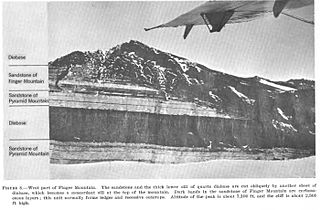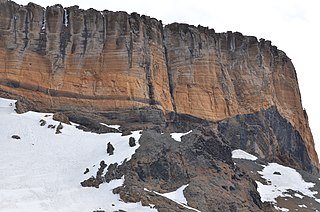 W
WThis is a list of fossiliferous stratigraphic units in Antarctica.
 W
WThe Beacon Supergroup is a geological formation exposed in Antarctica and deposited from the Devonian to the Triassic. The unit was originally described as either a formation or sandstone, and upgraded to group and supergroup as time passed. It contains a sandy member known as the Beacon heights orthoquartzite.
 W
WThe Fremouw Formation is a Triassic-age rock formation in the Transantarctic Mountains of Antarctica. Fossils of prehistoric reptiles and amphibians have been found in the formation. Fossilized trees have also been found. The formation's beds were deposited along the banks of rivers and on floodplains. During the Triassic, the area would have been a riparian forest at 70–75°S latitude.
 W
WThe Hanson Formation is a geologic formation on Mount Kirkpatrick, Antarctica. It is one of only two major dinosaur-bearing rock groups found on the continent of Antarctica to date; the other is the Snow Hill Island Formation and related formations from the Late Cretaceous of the Antarctic Peninsula. The formation has yielded only a handful of Mesozoic specimens so far and most of it is as yet unexcavated. Part of the Victoria Group of the Transantarctic Mountains, it is below the Prebble Formation and above the Falla Formation. The Formation is related to the Volcanic Activity Linked to the Karoo-Ferar eruptions on the Lower Jurassic. The climate of the zone was similar to the modern Southern Chile, Humid, with a temperature interval of 17–18 degrees.
 W
WThe Hidden Lake Formation is a Late Cretaceous geologic formation in Antarctica. The sandstones and siltstones of the formation were deposited in a deltaic environment.
 W
WThe James Ross Island Volcanic Group is a stratigraphic unit of Cenozoic age distributed on James Ross Island and Vega Island of the James Ross Island group, the Tabarin and Trinity peninsulas of Graham Land and surrounding islands in the Prince Gustav and Antarctic sounds.
 W
WThe La Meseta Formation is a sedimentary sequence deposited during the Eocene. The formation is found on Seymour Island, Antarctica.
 W
WThe Lashly Formation is a Late Triassic (Carnian) geologic formation in Victoria Land of Antarctica. The formation has provided fossil flora and indeterminate reptiles and dicynodonts.
 W
WThe Lopez de Bertodano Formation is a geological formation in the James Ross archipelago of the Antarctic Peninsula. The strata date from the end of the Late Cretaceous to the Danian stage of the lower Paleocene, from about 70 to 65.5 million years ago, straddling the Cretaceous-Paleogene boundary.
 W
WThe Mawson Formation is a geological formation in Antarctica, dating to roughly between 185-181 million years ago and covering the Pliensbachian-Toarcian stages of the Jurassic Period in the Mesozoic Era. Vertebrate remains are known from the formation.
 W
WThe Minaret Formation is a Late Cambrian limestone formation of the Heritage Group of Antarctica. The age of the formation is established to be Guzhangian to Cambrian Stage 10, dated at ranging from 500 to 488 Ma.
 W
WThe Santa Marta Formation is a geologic formation in Antarctica. It, along with the Hanson Formation and the Snow Hill Island Formation, are the only formations yet known on the continent where dinosaur fossils have been found. The formation outcrops on James Ross Island off the coast of the northern tip of the Antarctic Peninsula. In its entirety, the Santa Marta Formation is on average one kilometer thick.
 W
WThe Shackleton Limestone is a Cambrian limestone formation of the Byrd Group of Antarctica. The age of the formation is established to be Cambrian Stage 3, dated at ranging from 520 to 516 Ma. This period correlates with the End-Botomian mass extinction. Fossils of trilobites and Marocella mira and Dailyatia have been found in the formation, named after Ernest Shackleton, who led a failed expedition into Antarctica. At time of deposition, the Antarctic Plate has been established to be just south of the equator as part of the supercontinent Pannotia, contrasting with its present position at 82 degrees southern latitude.
 W
WThe Snow Hill Island Formation is a Late Campanian geologic formation found on James Ross Island, James Ross Island group, Antarctica. Remains of a paravian theropod Imperobator antarcticus have been recovered from it, as well as the elasmarian ornithopods Trinisaura santamartaensis and Morrosaurus antarcticus, the nodosaurid Antarctopelta oliveroi, and the shark Notidanodon sp. Alongside these described genera are also the remains of indeterminate elasmosaurids, lithostrotian titanosaurs and an indeterminate pterosaur.
 W
WThe Sobral Formation is a palaeontological formation located in Antarctica. It dates to the Danian stage of the Lower Paleocene period.